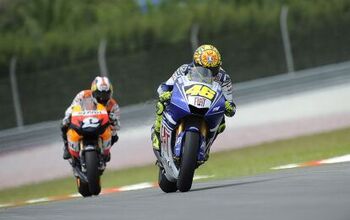The Anatomy and Development of the Grand Prix Motorcycle
This book is like one of those unknown videos that you end up renting because it has a good title and a nice cover. Actually, it isn't, because sometimes those videos turn out to be pretty good. This book is at once delightful and disappointing because it was written primarily from the viewpoint of a race car aficionado. It is filled with gems from interviews with many of GP's finest talent, but overall takes a beginners view of not just GP motorcycles, but roadracing bikes in general. It reads more like something influenced by, but never equaling, Kevin Cameron's pieces.
This book is at once delightful and disappointing because it was written primarily from the viewpoint of a race car aficionado.
For example, almost half of the section on engines belabors the operation of the two stroke motor for the benefit of the layman, without too many specifics on the current state of the art. It is confusing at times, inferring that four stroke engines are heavier because of the valvetrain, without explaining that two stroke engines don't use valves. Considerable verbiage is employed where a few diagrams would have done the job. The "big bang" motors are described as having a "narrow power band" because powe r is delivered over a shorter portion of the crank's rotation, when to the average reader, a narrow powerband means that peak power is delivered over a short portion of the rev range. Half of the captions are lifted almost directly from the text, and most of the information is redundant. The four stroke ancestry of GP is relegated to a sidebar, and the technical aspects of some truly hot engine topics such as data acquisition, advanced composite materials, variable intake tracts, and fuel injection are ei ther mentioned in passing or ignored completely. After reading the technical sections, a neophyte may feel enlightened, but a hard core motorhead will be disappointed. It should really have been called "500GP bikes and how they differ from F1 cars"However, the author was granted significant access to top riders and tuners, and many of the quotes are revealing and entertaining. Kenny Roberts' description of being chastised by Kel Carruthers for dragging his knee is extremely funny. The sidebars on vintage racebikes are interesting, although they leave the reader wondering what sort of progression truly succeeded the featured bikes. But more to the point, the development of modern GP machinery is not fully traced, nor is detailed anatomy of current bikes revealed. The pictures don't explain much about the anatomy in question, and there are no diagrams or charts. The author is rightfully amazed by the skills involved with 500 GP racing, but scant mention is made of 250s, and none is made of 125s.
Anatomy and Development of the Grand Prix Motorcycle would make a fine present for a racecar enthusiast who is interested, but not particularly knowledgeable about motorcycles. It is clear that the book was not written by a true expert in the field. The book won't do much for anyone who even reads a little bit of GP racing coverage. The shame of it is that it uses a title that someone else could have made into a must-have book. It should really have been called "500GP bikes and how they differ from F1 cars". The Anatomy and Development of the Grand Prix Motorcycle, by Tony Sakkis, is available from Classic Motorbooks for $21.95, 164 pages, soft cover.
Motorcycle Online rating: **1/2
More by Paul Peczon



























Comments
Join the conversation